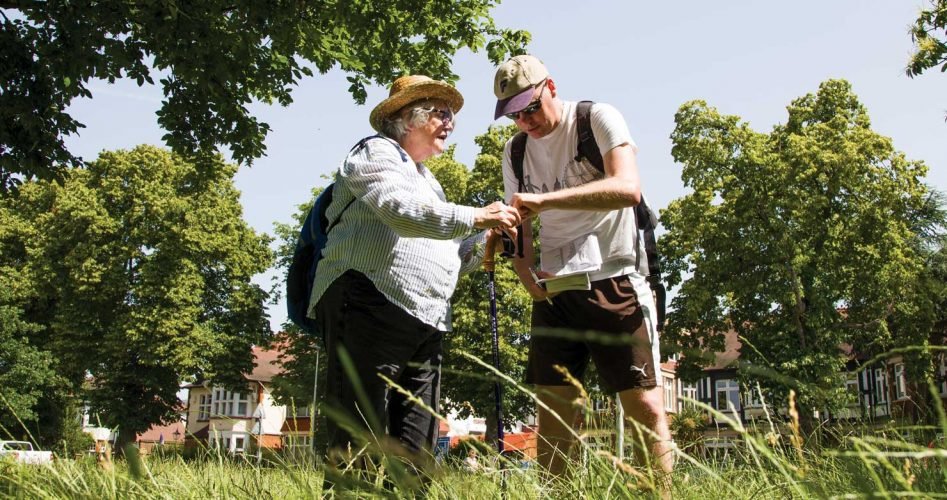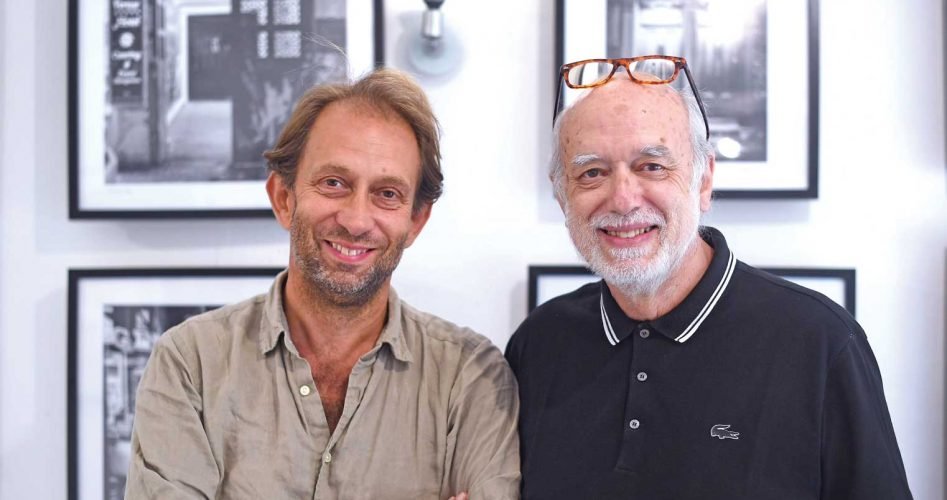September 2019
In the 16th of a series of articles charting the Wild Wanstead project – which aims to transform Wanstead into a multi-garden nature reserve – Iain Ambler provides an update on work to rewild parts of George Green. Photography by Alex Deverill
Lots of Wanstead residents will be familiar with the term rewilding. It’s a concept that’s gaining increasing currency in the UK in the conservation debate. It refers to the restoration of an area of land to its natural state, particularly to reintroduce species of animals or plants.
The most famous example is the Knepp Estate in Sussex, which since 2001 has seen extraordinary increases in wildlife. Rare species like nightingales and purple emperor butterflies are breeding well there and populations of common species are growing at an astronomical pace. Rewilding is bringing hope that the UK can reverse the, frankly, alarming trends of biodiversity loss seen over the last 70-plus years.
So far, so good… but could a form of rewilding happen in an urban environment? Say, in the middle of urban Wanstead? What would happen if nature was allowed to just do its thing here?
Wild Wanstead has been working with Redbridge Council to undertake a trial to find out exactly that. Areas of parkland and several road verges have been left unmown to see what might emerge naturally, and to allow native wildflowers and plants to grow taller over the summer, providing nectar and habitat for insects, and to set seed by the autumn and be dispersed, spreading biodiversity. The trial site at George Green was surveyed to see what had emerged and the value of this approach for wildlife. And the signs were quietly encouraging:
We recorded over 80 species of trees and plants, most of them native (not garden escapes). Just think about that for a second. Would you have said even 10 species existed on the Green?
Many native British wildflowers grow tall if left unmown, and these have flowered as a result of the project. Some examples: the beautiful pink of common mallow, the tall spear-like shape of goat’s beard (or Jack-go-to-bed-at-noon), lemon balm and common ragwort, which will provide food for the caterpillars of the cinnabar moth.
We found some nice insect species in the long grass areas, including the Essex skipper butterfly. Why are they here? Their caterpillars will typically eat grasses such as cocks-foot, Timothy and common couch, all native grasses which have grown tall in central areas of the site. Butterflies like the understory the long grasses provide as shelter from predators.
We found indicator grass and plant species, evidence that all but confirms that George Green is a likely fragment of old acid grassland, the sort of place where highwaymen and bandits of old might have hidden out.
Then there’s just the sheer beauty – at least to this eye – of the wind blowing waves through stands of wildflowers and long grass of different colours, forms and heights against the backdrop of local residents enjoying the Green on a hot summer’s day.
So, overall, there are signs that, when left alone, nature returns, even to the middle of an urban environment.
If you have enjoyed George Green and like the idea of areas in Wanstead being left to return to nature over the summer, do let the council know via their parks email, (parks.enquiries@visionrcl.org.uk). It’s vitally important they know we care, so we can continue and extend this experiment. Let’s rewild Wanstead!
Find out more about the plants and insects found during the George Green survey in next month’s issue. For more information on the Wild Wanstead project, visit wnstd.com/wild
In the second of a series of articles looking at the work of Age UK Redbridge, Barking & Havering, local artist Brenda Coyle explains why picking up a brush could be just what the doctor ordered
Lots of people come in and ask about the old Cherry Tree Café. Do you remember the one on Woodbine Place, by the buses? Called the Cherry Tree, of course, as it once housed within its walled garden a (now deceased) large, beautiful cherry tree, which bloomed every spring with gorgeous pink blossoms.
Nowadays, the doors are open again, but this time it’s become a wonderful space for arts and craft classes, luckily part of Wanstead’s Allan Burgess Centre, supported by Age UK Redbridge, Barking & Havering. Various art-based activities are on offer, ranging from loom weaving and clay modelling to jewellery making and painting, to name but a few.
We are all aware that the arts are fast becoming an important element in building our wellbeing, not just for ourselves, but for our friends and families. Doctors and other primary care professionals are often social prescribing and referring people to join art-based classes, not just to learn and enjoy a new fun activity, but through many years of research, they now recognise that creating art is proven to relieve stress and relax our busy minds and bodies. This is done by supplementing medicine and our usual care, which is still very important, but the arts are now a documented factor in improving the mental and physical health of our community.
I run such classes right here in Wanstead at the Cherry Tree Café every Tuesday afternoon. The classes are small, which enables each student to choose their own level and capabilities. Recently, we focused on Van Gogh and produced some stunning pieces of work. As we have a visually impaired student in our class, I always ensure the whole class works together, so I brought in some visual aids from the charity Living Paintings. This meant the students could use all their senses to visualise some of the famous painter’s work. We then moved on to using real sunflowers and even took some apart. I always want my students to feel they are included in all the lessons, whatever their abilities. We make a point of all sitting together and sharing our art.
Teas and coffees are served and a group of fantastic volunteers help set up. Bob (Robert Butler) is fantastic and comes every week, rain or shine. He is our strong man and brilliantly sets up and takes down all the chairs and tables for us during the day. Peter Chamberlain (who runs the bridge class at the Allan Burgess Centre) comes in the afternoon when we are finishing. His job is to put all the furniture away, but he also has a secret mission: he is a potter and owns his own kiln, which comes in very handy when we need our clay creations fired! Kate or Kathleen take the register and greet all our students. Both are wonderful at making our students feel at ease.
Brenda’s art classes run at the Cherry Tree Café, 25 Woodbine Place, Wanstead every Tuesday from 2pm to 4pm (£30 for 10 weeks). For more information, call 020 8989 6338 or visit wnstd.com/ageuk
As the children head back to school, accountancy examiner and Wanstead resident Steve Wilks offers his advice for preparing for the next season of exams
The summer holidays are over; the nights are drawing in and a new term is starting. For many of Wanstead’s students, this means embarking on final year exams, whether at GCSE or A level. This will determine a student’s university choices and ultimate career path. Examinations are the traditional way of assessing this, and it is essential students develop a good exam technique to maximise the best result possible.
It is important to familiarise yourself with the examination requirements – whether it’s multiple choice questions, short form structured questions or essay writing – and how these will be assessed. It is also essential to pay attention to the mark allocation for a question. Clearly, an answer worth 10 marks will often require a longer, more detailed response than a one- or two-mark answer. Often, small marked allocation questions are marked on a penny points’ system, so a two-mark question will require two points or one point well explained – the further explanation being worth a mark. Use the mark allocation as a guide to tailor your response.
With essay-style questions, there is usually a bit more flexibility and often answers are marked on a “levels of response” basis to reward a level of thinking. This differs between examination boards, but generally speaking, listing and explaining points score marks at the lower levels, with further analysis (perhaps with an example and synthesis showing how the points relate to each other) scoring much higher marks. At the top of the spectrum of answers, if a candidate can evaluate an answer, this will often score the most marks of all as it demonstrates there has been a balanced assessment of a topic. Remember, in essay-based questions, an answer is rarely black or white, it is often a shade of grey, and candidates who reflect this will score highly.
Reading widely also helps, particularly in the topical social science subjects. Examiners often set questions based on stimulus 18 months before the real exam where relevant. Therefore, you may come to familiarise yourself with the subject matter already from wider knowledge, which may give you an advantage over other students.
It is also important to note that in numerical subjects, such as accountancy, marks are awarded for principles as well as the number itself. Often, calculations will involve a process a candidate needs to go through to arrive at the final answer. Many candidates may not get this wholly correct, but if they apply the figures they calculate to the principles required from the question, they will get follow-on marks.
With extensive examination practice using mocks at school and effective revision techniques, most students should be able to achieve a good pass. Good luck.
For more information on qualifications and exams, visit wnstd.com/ofqual
Stanley and Brenda Lopata will be using this month’s Wanstead Festival to champion the work of their daughter, who is striving to improve the UK’s seas and beaches through her charity Sea-Changers
Seven years ago, my husband, Stanley, and I moved to this area after having lived in the same house in Buckhurst Hill for 44 years. According to popular wisdom, this should have been a really traumatic experience, but it has turned out to be a wonderful new phase in our lives.
We love Wanstead – its diverse and vibrant community and its proximity to London and Epping Forest. However, one thing that Wanstead cannot boast is a marine and coastal environment. Why then are we choosing to put our efforts into supporting the charity Sea-Changers? Let me explain.
Since we moved, we have both been attending art classes and were delighted to have pieces of work in group exhibitions during last year’s art trail. We both joined Art Group Wanstead and we wanted to be involved in the Wanstead Festival, but as amateurs, we didn’t want to take a venue in the High Street to display our work.
Back to Sea-Changers. This is a charity set up nine years ago by our daughter, Rachel, and her partner, Helen. They have been scuba-diving for many years and have seen how dramatically the marine environment is deteriorating, how beaches are polluted by plastics and how wildlife is being decimated. They have worked tirelessly, with an amazing team of volunteers, to make a difference to the seas and beaches around the British Isles, funding research projects, organising beach cleans and raising awareness in schools and workplaces. So many people, whether they are regular sea users or city dwellers, are now concerned about the state of the oceans.
We have secured a stall at the Wanstead Festival, and we have asked local artists, many of whom we have met through our art classes, to consider donating a piece of their work to Sea-Changers. On 15 September, we will be displaying their artwork on our stall and asking festival-goers to donate to the charity and choose a work on paper for £5, on board or canvas for £10 or a framed piece for £20. We are delighted by the response from artists, who are being very generous and seem more than pleased to be supporting this important charity. We have also arranged a link on Art Group Wanstead’s Charity Aid Foundation giving page. This means anyone reading this article who cannot visit the festival but who wishes to support the charity can do so.
A sea life art workshop will also take place at the festival to tie in with our stall’s theme and we hope that Wanstead landlubbers will be inspired by the Sea-Changers story.
For more information on the workshop, visit wnstd.com/art.
To find out more about Sea-Changers and to make a donation, visit wnstd.com/sea
Devonsbrook Bathrooms (3–5 Devon House, Hermon Hill) will display a range of the Lopatas’ paintings during the art trail to support Sea-Changers.
To find out more about Sea-Changers and to make a donation, visit wnstd.com/sea
Devonsbrook Bathrooms (3–5 Devon House, Hermon Hill) will display a range of the Lopatas’ paintings during the art trail to support Sea-Changers.
Lots of people love the idea of installing a green roof but don’t know where to start. An event at this year’s Wanstead Fringe aims to change all that. Susie Knox from Wild Wanstead reports
There’s a revolution going on in London. But if you want to see it, you’ll need to look up… Green roofs are appearing on buildings around the capital, creating a patchwork of vegetation across the skyline.
According to a report from the Mayor of London, there are now 1.5 million square metres of green roof in Greater London. It might be new to the UK, but green roof technology is well established in countries like Germany, Austria and Switzerland. That means there’s now a substantial body of evidence quantifying the enormous benefits of making gardens in the sky.
A green (or living) roof is one where vegetation or a habitat for wildlife is deliberately established. They can be on an impressive scale – creating parkland, areas to grow food or even bespoke habitats for wildlife. But for residential developments, they are usually what’s called an ‘extensive’ green roof, which means they are low maintenance and once established, largely look after themselves. They are vegetated with low-growing, drought-tolerant plants like stonecrop (sedum) or dry meadow grasses and wildflowers.
Whatever the type, green roofs bring a whole load of benefits – some visual, some environmental and some even financial. These include providing insulation in winter and a cooling effect in summer (which can help reduce energy bills), extending the life of the roof, supporting biodiversity, improving air quality, capturing carbon, reducing noise and creating the green aspect known to enhance health and wellbeing (as well as looking a lot more attractive than roofing felt!).
So, are people in Redbridge benefitting from the perks of green roofs? Well, at the moment, not so much, at least not compared to our neighbours in Waltham Forest and Newham. But there’s no reason why that shouldn’t change.
Green roofs make a fantastic option for residential extensions – probably one of the most frequent developments here in Wanstead. They can be installed on existing roofs or at the time an extension is being built.
If you want to find out more, an event is being held as part of this year’s Wanstead Fringe, which aims to provide a practical guide focusing on how to install a living green roof on your extension. The speaker is Chris Bridgman from green roof specialists Bridgman & Bridgman, who will provide practical demonstrations, case studies and a step-by-step guide to turn your roof from grey to green.
The talk will take place at The Larder, 39 High Street, Wanstead on 10 September from 7.30pm to 8.30pm (free). For more information on Wanstead Fringe events, visit wnstd.com/fringe19
The island flower bed outside Wanstead Station is looking somewhat neglected and doesn’t live up to the Wanstead Community Gardeners’ usual high standards. It’s a work in progress, reassures Marian Temple
The island bed between The George pub and Wanstead Station has been looking rather desolate for some time. An old water tank with ‘Wanstead Community Gardeners’ on it announces that it is one of our patches, but it has caused us problems since we took it over about three years ago.
The soil is very poor, dry and stony, not really a problem but the couch grass is and threatens to overrun the area. Our councillors suggested we could apply for a Community Infrastructure Levy (CIL) grant to have some preparatory work done to give us a more level playing field, something we could cope with.
CIL grants come from developers who pay the council for infrastructure their new development might cause to be needed (such as helping to pay for schools, leisure centres, healthcare facilities and transport schemes). A percentage of this goes to local group projects for the improvement of the area. What we needed fitted in perfectly with this. We applied for the grant (a lot of hoop-jumping) and were successful as anticipated. We have been improving Wanstead since 2003, starting with the Corner House garden, and have never asked for anything in the way of funding.
With advice from Simon Litt of Valentines Mansion gardens and others, we decided to go for a wildflower meadow in the open part, which is our patch. In the meantime, the council had all the shrubs cut down in the long neck towards the traffic lights. This for reasons of impeding drivers’ sight lines. If we can get them to remove all the roots, we can include the neck in our project.
We hope to create a wildflower meadow, which would make a wonderful entrance into Wanstead. Drivers already enjoy our drivers’ beds as they wait at the traffic lights. Meadow plants can cope with poor, dry, stony soil, and while not being maintenance free, we should be able to cope with this. Keeping the drivers’ sight lines free will be an important consideration regarding the height of plants.
We are not sure what the timing will be for all this. It might very well be 2020 before this ugly duckling becomes a swan and delights all who see it, whether on foot or in cars. This is indeed a work in progress.
It’s been a long journey for your community gardeners, but we have great hopes for this rather sad patch of public soil.
For more information on the work of the Wanstead Community Gardeners, email gardeners@wnstd.com or leave a note for them at Wanstead Library.
As Art Trail Wanstead clocks up a decade, founder Donna Mizzi looks forward to 2019’s time-themed event and explains why more residents are getting involved in creating art than they did 10 years ago
Over the space of just 10 years, we have noticed that art is considered less the preserve of a few talented individuals to being more an activity that people of all ages and abilities can engage in. And the trail has shown that individuals do not always have to spend years at art school to create work that is admired or appreciated by members of the public. That said, many of our members have at some time joined local classes, courses or groups.
It may be a change in society as more people find art accessible, relaxing, therapeutic and a break from uncreative jobs. And, of course, it may be the art trail that has helped drive that change and broken down some barriers. The volunteers involved certainly hope so. Organiser and Wanstead House tutor Anna Bisset says the trail can act as “a stepping-stone into a community of people who are making and enjoying art, or even as a bridge from art student to professional artist – a really transformative experience!”
Another valuable seam of artistic ability has been mined by Eugene Coyle via his trail art postcard project. Encouraging anyone to send in their own art card on this year’s theme ‘Time’ has revealed many more impressive artists living locally. At the trail, come and see the postcard art. Or even better, come to Eugene’s stall at the Wanstead Festival and produce some of your own.
Our local trail has forged new friendships, built a stronger community spirit and added beauty and colour to the area – several businesses are now keeping the trail’s artwork on show all year. Thank you to restaurant Filika, The Manor House, La Bakerie and The Stow Brothers, plus TfL for allowing artwork at Wanstead Tube station… and to any more that will join them in the future. The trail has added verve to the Wanstead Festival and helped inspire the setting up of the Wanstead Fringe seven years ago. It also reaches out to help encourage crafts people and designer-makers.
All this would not have been possible without a small band of volunteers from the organising Art Group Wanstead, some of whom have been involved from the start. Take a bow art tutors Patrick Purcell, Ron Filer and Anna Bisset. Special thanks to Tomasz Wlodarczyk and Angela Daley, who each ran a trail for Wanstead. And to Jeanette Cole, Sally Asbury and Alison Stenhouse, among others, whose help has been invaluable. Many other wonderful volunteers – too numerous to mention here – have pitched in to help over the years.
And it couldn’t have happened without our sponsor The Stow Brothers, the Wanstead Village Directory and our local newspapers, the shops, cafes, pubs, businesses and community centres. Many grateful thanks. There’s no doubt about it, Wanstead has community building down to a fine art.
Art Trail Wanstead will take place from 7 to 22 September. Visit wnstd.com/art
The big news for last year’s Wanstead Fringe was the event’s first professional theatre production. This year, there are three. Chloe Longstaff takes a look at each
Truly celebrating diversity in theatre, this year’s Wanstead Fringe is hosting three contrasting performances, offering something for all ages and interests.
First up is The Border, an outrageous Brechtian parable that explores the lines we draw between ourselves and other people. Staged by Theatre Centre, which was founded in 1953 and has decades of experience at bringing new writing to audiences, The Border is a timely and thought-provoking contribution to our questions of identity; life is about to be turned upside down for one small town as the border crossing is sealed shut, dividing here from there, us from them, this from that. In the midst of it all, Stranger, a young girl’s beloved dog, has gone missing. Will Stranger be found before the border closes, or will he be trapped forever on the ‘wrong’ side? This play is suitable for children aged 13-plus and will be particularly useful to young audiences, though relevant to everyone. It’s a must for anyone studying drama, citizenship and PHSE.
We Must Throw The Cows Down The Ravine is our next production, by an award-winning theatre company, adapted from the best-selling book Voices of the Labyrinth by Spanish author Ricard Ruiz Garzon, where the reality of schizophrenia is explored. Told from the view of both patients and family members, these true testimonials challenge the stigma and discrimination experienced by people dealing with mental health issues and help us realise each individual’s journey is a very personal one. The show was first produced in Caracas, Venezuela and is now touring Europe. In June, it opened at Teatro La Maquina in Valenica before moving to the renowned Teatro Español in Madrid. In July, it transferred to London where it was performed at the Cervantes Theatre, and it will now be performed (in English) at the Wanstead Fringe!
Last but not least is The Railway Children. This heart-warming tale is set to a stunning new musical soundtrack, bringing a touch of magic to the stage. When Roberta, Peter and Phyllis move to the country with their mother, they discover the joys of the steam railway and make new, unexpected friends. The only thing missing is their father. Brought to the Wanstead Fringe by the company who last year delighted audiences with sell-out performances of The Secret Garden and performed in the impressive Deaton Theatre at Forest School, this is an opportunity to see a West End-style musical right on your doorstep.
The Border: 13 September, 7.30pm at Aldersbrook Community Centre.
We Must Throw The Cows Down The Ravine: 13 and 14 September, 8.15pm at Our Lady Of Lourdes Church Parish Centre.
The Railway Children: 14 September, 3pm and 7pm and 15 September, 3pm at the Deaton Theatre, Forest School.
To book tickets, visit wnstd.com/fringe19
In the second of a series of articles looking at the redevelopment of Whipps Cross Hospital, Wanstead resident Charlotte Monro explains why she is supporting a petition calling for government funding
Our community desperately needs a new hospital. Rebuilding Whipps has wide support, not least in Wanstead, as I discovered when gathering signatures on the High Street for our petition calling on the government to fund the build.
Quite a team is now set up at Whipps, working on more detailed proposals for the new hospital. I recently attended a community partners’ workshop as one of five Waltham Forest Save Our NHS delegates. Redbridge was also well represented with Councillor Dan Morgan-Thomas and Mike New, chair of Redbridge Health Watch. We were told the redevelopment work from now until September is focused on (one) developing ideas for how health services will be delivered in the future and the size of hospital needed, and (two) options for the land occupied by Whipps. This will inform a revised ‘Strategic Outline Case’ to be submitted to the NHS powers that be in December, the first hurdle for government approval.
I believe it is vital that we, the communities who rely on our hospital, have a determining voice in these decisions. Certainly, this was the spirit among people attending the workshop.
Discussion about the future shape of services showed peoples’ concern that the hospital must be designed with enough beds. They challenged the realism of expectations that care in the community – already over-stretched – will significantly reduce the need for hospital care, and therefore the size of hospital needed. Back in 2016, the local health strategy made this assumption; some excellent community intermediate care services are now in place, but pressure on hospitals appears no less. “Rigorously evaluate predictions around bed numbers – have previous plans achieved what they promised?” is the message now recorded. Even the head of NHS England says the loss of beds has gone too far, we now need more.
Can our new hospital be a model for environmental design? This we also asked. Surely, as we face the tipping point for climate change, this is a time for a carbon neutral hospital. The healthcare sector is responsible for anywhere from 3–10% of all carbon emissions worldwide. But some hospitals around the world have paid dividends through design features, such as those that allow natural sunlight to permeate throughout the building, offering the dual benefit of cutting back on winter heating costs and offering proven health benefits for patients over artificial lighting. So, where and how the new Whipps is positioned on the site could be crucial. Expertise in environmental design must be brought in now.
Such an investment in a new hospital with enough beds for the growing population is a priority. Without adequate funding, it cannot happen. Please sign our petition and share it.
For information on the future of Whipps Cross Hospital, visit wnstd.com/whipps
To view the petition, visit wnstd.com/wxp
Two award-winning professional photographers will be offering an insight into their working lives at a Wanstead Fringe event on 11 September.
Geoff Wilkinson, who runs Gallery 84 on Nightingale Lane, and Stefan Rousseau, the Press Association’s chief political photographer, will tell the stories behind the images that make it into the newspapers and magazines.
Entitled ‘A picture is worth a thousand words’, the event will take place at Geoff’s gallery from 7.30pm to 9pm (tickets: £10).
Visit wnstd.com/fringe19
A murder mystery evening will take place at Wanstead Library this month to mark Agatha Christie Week.
“Join a cast of colourful characters all set on dining with death! When Mr Boddy asks Lady Peacock to be his bride, the wedding breakfast turns to dead-over-dinner, as the new vicar, Rev Green, hears confessions,” said a spokesperson.
Set at Waddingtons Hall, participants will need to question the suspects to catch the killer.
The event will take place on 14 September from 6.30pm (tickets: £6).
Call 020 8708 7400













